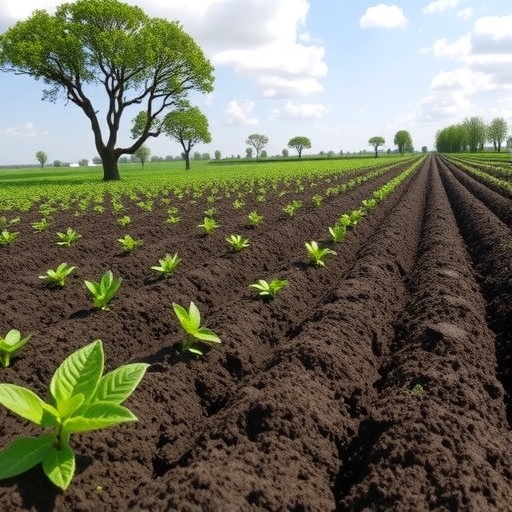In a groundbreaking synthesis published in the prestigious journal CABI Agriculture and Bioscience, Dr. Nicholas Bardsley from the University of Reading delivers a comprehensive and critical appraisal of regenerative agriculture (RA), a movement rapidly gaining momentum amid pressing global environmental challenges. This extensive review reframes regenerative agriculture not merely as a collection of innovative practices but as a transformative paradigm rooted in ecological science and systems thinking, urging a fundamental reconsideration of how humanity cultivates the land.
As soil degradation accelerates worldwide, compounded by climate instability and diminishing biodiversity, conventional agricultural methods increasingly fall short in sustaining productivity and ecological balance. Dr. Bardsley’s review underscores the urgent need to move beyond extractive farming towards an approach that actively restores and revitalizes soil health. Central to this is the concept of engaging with natural nutrient cycles, carbon flows, and hydrological processes to regenerate fertile, resilient ecosystems—anchoring RA firmly in the principles of ecological restoration science.
The review contends that defining regenerative agriculture has been fraught with ambiguity and contested interpretations. Rather than prescribing a rigid set of techniques, Dr. Bardsley proposes a definition centered on ecological outcomes: practices that demonstrably improve soil function, enhance biological activity, and bolster resilience to environmental stresses. This adaptive framework allows RA to be context-specific and farmer-led, recognizing the diversity of agroecosystems globally and the importance of place-based knowledge.
Emerging soil science forms a crucial foundation for this narrative. Contradicting older assumptions that soil degradation is irreversible or necessarily slow to recover, recent research reveals that complex biological processes within soil—particularly the interactions between plants and microbes—can rebuild organic matter and soil structure at surprisingly rapid rates. This dynamic soil “food web” is integral to cycling nutrients and retaining water, offering a living system perspective that challenges conventional mechanistic views of soil fertility.
Dr. Bardsley details how RA practices such as cover cropping, minimal or zero tillage, strategic livestock integration, and the application of biological inputs leverage these biological processes. These approaches foster microbial diversity and activity, reinvigorating nutrient flows and water retention mechanisms. Importantly, regenerative farmers do not simply aim to conserve degraded soils but actively strive to reconstruct what has been lost, embodying an ethos of ecological reciprocity.
Beyond soil health, regenerative agriculture delivers a multifaceted suite of ecological co-benefits. Enhanced carbon sequestration stands out as a critical element with the potential to mitigate climate change by drawing atmospheric carbon dioxide into stable soil pools. Simultaneously, the reduction or elimination of synthetic agrochemicals diminishes emissions and pollution, helping to preserve ecosystem services while promoting biodiversity recovery both above and below ground. These interconnected effects contribute to ecosystems that are more resilient against drought, pests, and market uncertainties.
The review also points to emerging evidence linking soil quality with crop nutrient density and broader human health outcomes. Improved soil microbiomes may enhance the nutritional profiles of crops and potentially bolster immune system resilience in populations exposed to soil-based microbes. Such societal co-benefits position regenerative agriculture as a promising contributor to public health objectives, integrating agricultural and medical science in novel ways.
Despite these transformative potentials, the adoption of regenerative agriculture faces substantial systemic obstacles. Dr. Bardsley highlights a pressing gap in long-term, systems-level public research funding, which limits the generation of robust evidence tailored to diverse agroecological contexts. Furthermore, dominant policy frameworks—exemplified by the UK’s Environmental Land Management schemes—are critiqued for their narrow emphasis on incremental environmental improvements rather than incentivizing holistic system redesign.
Moreover, market-based certification schemes aimed at promoting regenerative products risk becoming vehicles for greenwashing. The review warns that inappropriate commodification could dilute the ecological integrity and farmer-centered ethos of the regenerative movement. Instead, Dr. Bardsley advocates for policies and support mechanisms that prioritize farmer knowledge, localized experimentation, and rigorous ecological monitoring, fostering innovation from the ground up.
Framing regenerative agriculture as a new paradigm rather than a set of piecemeal technical fixes, the review calls for a systemic shift in scientific inquiry and policymaking. A systems thinking lens is essential to appreciating the complex interactions in farming ecosystems—recognizing soil and farm landscapes as living, dynamic entities with reciprocal relationships between humans and nature. This conceptual leap challenges entrenched agricultural models and opens pathways for sustainable intensification aligned with ecological resilience.
To realize the promise of regenerative agriculture, the paper urges researchers, funders, and institutions to commit substantial resources toward integrative, systems-level research projects. These should reflect the heterogeneity of farming practices worldwide and center regenerative farmers as co-creators of ecological knowledge. Embracing this collaborative approach could accelerate the transition to regenerative food systems, with profound implications for ecosystem health, climate stability, and human well-being.
This review marks a timely and incisive contribution to the discourse on sustainable agriculture. It offers a scientifically grounded, yet practical, vision for a future in which farming regenerates the land rather than depleting it—a vision that is both urgently needed and increasingly attainable. Dr. Bardsley’s synthesis invites policymakers, scientists, and practitioners alike to engage with regenerative agriculture as a dynamic, evolving science and movement poised to reshape global food systems.
By integrating peer-reviewed scientific insights, practitioner experiences, and emerging soil ecology breakthroughs, this paper situates regenerative agriculture at the forefront of agroecological innovation. It captures a moment where old narratives of soil exhaustion yield to hopeful evidence of renewal, catalyzed by human stewardship informed by deep ecological understanding. In a world grappling with environmental crises, regenerative agriculture offers a beacon of restorative potential and a pathway to resilience for future generations.
Subject of Research: Not applicable
Article Title: Regenerative Agriculture: its Meaning, Rationale, Prospective Benefits and Relation to Policy
News Publication Date: 21-Aug-2025
Web References: http://dx.doi.org/10.1079/ab.2025.0062
References: Bardsley, N, ‘Regenerative Agriculture: its Meaning, Rationale, Prospective Benefits and Relation to Policy,’ CABI Agriculture and Bioscience, 21 August 2025, DOI: 10.1079/ ab.2025.0062
Image Credits: Pixabay
Keywords: regenerative agriculture, soil health, ecological restoration, carbon sequestration, system thinking, agroecology, soil food web, climate mitigation, sustainable farming, biological inputs, policy challenges, farming resilience




